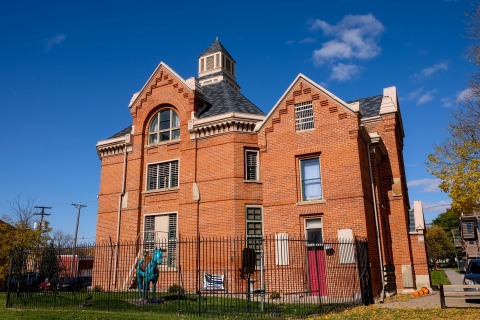About Pottawattamie County
Mission Statement
The purpose of Pottawattamie County government is to provide the highest quality government possible to the citizens of Pottawattamie County, Iowa, and other governmental entities in the most efficient and cost effective manner possible. It is also to encourage economic development, enhance our tax base and provide higher quality jobs for our citizens.
Philosophy
We, serving in the Pottawattamie County government, believe that public service requires recognizing the unique needs of our citizens and providing resources to be responsive to those needs. We are dedicated to providing professional, prompt and courteous service to meet the needs of our citizens. Our commitment to providing every citizen with high quality and cost effective public services will be the driving goal for every individual employed by Pottawattamie County.
Pottawattamie County’s philosophy is based on the following principles that guide the efforts of Pottawattamie County government.
- Provide the least intrusive government that serves the best interest of all citizens.
- View Elected and Appointed Officials as policymakers, and staff as implementers of policy.
- Encourage citizen participation in government and promote public trust and accountability.
- Administer a government that is competent and responsive to citizen’s needs while understanding its obligation.
- Adhere to the community’s strong work ethic, promoting high productivity with reasonable workloads.
- Foster an economic, social and physical environment that allows individual and corporate citizens to realize their potential.
- Encourage and recognize creativity, innovation and teamwork among County employees.
- Encourage administrative decision-making at the point of service.
- Administer county government with compassion and fairness.
Core Values
- Service and Accountability to Our Citizens
- Ethics and Integrity
- Job Knowledge & Skills
- Professionalism
- Self-Management
Pottawattamie County History
The county commissioners proposed Kanesville and Pleasant Grove, about 8 miles apart, for the county seat. At an election held April 7, 1851, all but seven votes were cast for Kanesville, named for Colonel Kane of Philadelphia. Council Bluffs was previously known as Hart’s Bluff and then Miller’s Hollow before it became Kanesville. The rapidly growing village had a population of about 7,000 at the time, mainly Mormons on their way from Nauvoo, Illinois to Utah. It was also an important outfitting town for gold seekers and others on their way to California and the West. Hyde’s New Hall at Kanesville, which was renamed Council Bluffs on January 19, 1853, was used for several years for the courthouse.
The historic courthouse on South Pearl Street was perhaps the most famous landmark in Council Bluffs for almost ninety years. Construction of the courthouse and the Squirrel Cage Jail began in 1885 and was completed in 1888, replacing the original courthouse, which dated to 1868. The new courthouse included an 11-foot-tall statue of Lady Justice. She was placed on a platform 74 feet above the sidewalk for some 90 years. The statue is now displayed in the lobby of the current 1978 courthouse. The ground for the new modern facility was broken in February 1975 and the building was dedicated November 20, 1977.

Photo courtesy of the Council Bluffs Convention & Visitors Bureau
The Squirrel Cage Jail was invented by William H. Brown and Benjamin F. Haugh of Indianapolis, Indiana. Seventeen human rotary or “squirrel cage” jails were built in the late 1800s. Only three of these remain. One resides in Council Bluffs and the others in Missouri and Indiana. The Council Bluffs jail is the only one left having three stories. The jail was designed to achieve maximum security with minimum personal contact between the prisoner and the jailer. The jail was placed on the National Register of Historic Places in 1972 and is now operated as a small museum. Interested visitors are permitted to “spend some time behind bars.”
Avoca is the judicial seat of eastern Pottawattamie County. This town of 1,500 residents was founded in 1869. It was originally known as Pacific, and then Botna. It was finally named Avoca in reference to a Thomas Moore poem entitled “The Meeting of the Waters”.
The Loess Hills (pronounced “luss”), which span the western part of the county, were once home to many prehistoric species. Mammoths, mastodons, camels, bison, musk ox, ground sloth, three-toed horses, dire wolf, stag moose, and stilt-legged deer were among the animal fossils discovered in the Loess Hills. Today the Loess Hills are home to many different species of birds, reptiles, and amphibians.
The Loess Hills of western Iowa were deposited in three stages during the last two major glaciations of the upper midwest. When continental glaciers in the upper midwest began melting, many rivers (including the Missouri River) became conduits for vast quantities of melt-water. This melt-water contained fine-grained sediment of silt, sand, and clay size. Strong winds created by air pressure gradients around glaciers swept some of this sediment out of the river floodplains and deposited it downwind creating the loess hills.
Loess in Iowa is separated into stratigraphic units based on the time that it was deposited. Each unit has been given a name and can be distinguished by its distinct chemistry and physical composition. The lowest layer of Loess is called the Loveland Loess and was laid down 160,000 to 120,000 years ago as the glacial epoch known as the Illinoian was coming to an end. After the Illinoian glaciers melted, there was a hiatus of glacial activity for approximately 100,000 years, after which glaciers returned during a period known as the Wisconsinan. The middle layer of loess was deposited from 31,000 to 25,000 years ago during a major retreat of glaciers during the Wisconsinan glacial epoch and is known as the Pisgah Loess. The last layer of loess, called the Peoria Loess, resulted from major melting at the end of the Wisconsinan glacial epoch and was deposited between 25,000 and 12,500 years ago. This makes the Loess Hills some of the youngest natural landforms in Iowa!

Photo courtesy of the Union Pacific Railroad Museum
General Grenville Mellen Dodge, is an important historical figure in Pottawattamie County. General Dodge organized the Fourth Iowa Volunteers and the 2nd Iowa Battery to serve in the Civil War. In 1864, the general lead a campaign to rid Missouri of guerillas who were terrorizing residents of the state. In 1866, he became Chief Engineer for the Union Pacific Railroad’s westward movement. He also became a United States Congressman that same year. On May 10, 1869, the Union and Central Pacific Railroads met in Promontory Summit, Utah. General Dodge’s crew had laid 1086 miles of track. In 1869, General Dodge and his wife, Ruth Anne Dodge, started construction of their home in Council Bluffs. The house is located at 605 Third Street. The General Dodge House is a National Historic Landmark. The house is now a museum that is open to the public. General Dodge died January 3, 1916, from cancer. He was 84 years old.
County Code
View the Pottawattamie County Code, including zoning and building ordinances.
At-A-Glance
- Established: February 24, 1847
- Organized: September 21, 1848
- County Seat: Council Bluffs
- Courthouses: Council Bluffs and Avoca
- Population: 93,667

